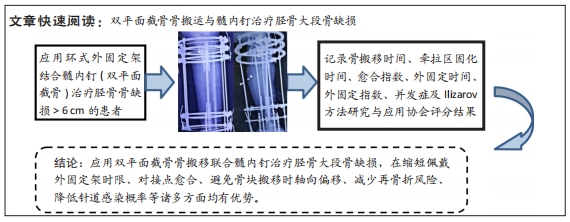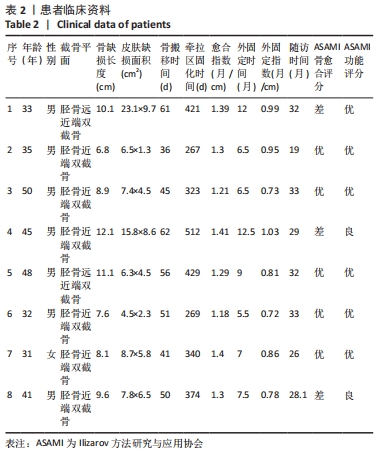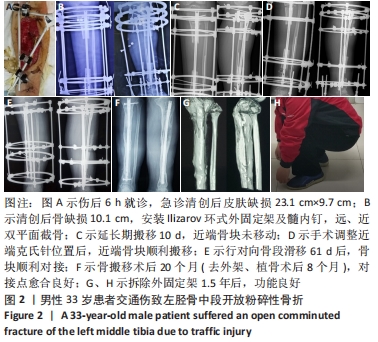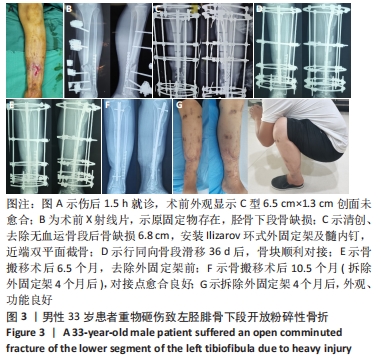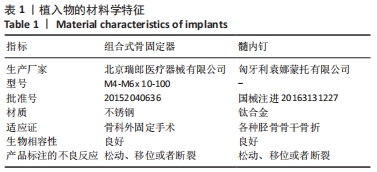[1] SALA F, THABET AM, CASTELLI F, et al. Bone transport for postinfectious segmental tibial bone defects with a combined ilizarov/taylor spatial frame technique. J Orthop Trauma. 2011;25(3):162-168.
[2] ROBERT ROZBRUCH S, WEITZMAN AM, TRACEY WATSON J, et al. Simultaneous treatment of tibial bone and soft-tissue defects with the Ilizarov method. J Orthop Trauma. 2006;20(3):197-205.
[3] FÜRMETZ J, SOO C, BEHRENDT W, et al. Bone Transport for Limb Reconstruction Following Severe Tibial Fractures. Orthop Rev (Pavia). 2016;8(1):6384.
[4] BORZUNOV DY. Long bone reconstruction using multilevel lengthening of bone defect fragments. Int Orthop. 2012;36(8):1695-1700.
[5] PALEY D, MAAR DC. Ilizarov bone transport treatment for tibial defects. J Orthop Trauma. 2000;14(2):76-85.
[6] DAVDA K, HEIDARI N, CALDER P, et al. ‘Rail and Nail’ bifocal management of atrophic femoral nonunion. Bone Joint J. 2018;100-b (5):634-639.
[7] LAMBIRIS E, PAPADOPOULOS A, KARABASI A, et al. Secondary intramedullary nailing after distraction osteogenesis: 30 patients followed for 2-12 years. Acta Orthop Scand. 2004;75(4):481-486.
[8] CHADDHA M, GULATI D, SINGH AP, et al. Management of massive posttraumatic bone defects in the lower limb with the Ilizarov technique. Acta Orthop Belg. 2010;76(6): 811-820.
[9] MADER JT, CRIPPS MW, CALHOUN JH. Adult posttraumatic osteomyelitis of the tibia. Clin Orthop Relat Res. 1999;(360):14-21.
[10] BORZUNOV DY, CHEVARDIN AV. Ilizarov non-free bone plasty for extensive tibial defects. Int Orthop. 2013;37(4):709-714.
[11] DENDRINOS GK, KONTOS S, LYRITSIS E. Use of the Ilizarov technique for treatment of non-union of the tibia associated with infection. J Bone Joint Surg Am. 1995;77(6):835-846.
[12] WAN J, LING L, ZHANG XS, et al. Femoral bone transport by a monolateral external fixator with or without the use of intramedullary nail: a single-department retrospective study. Eur J Orthop Surg Traumatol. 2013;23(4):457-464.
[13] BERNSTEIN M, FRAGOMEN A, ROZBRUCH SR. Tibial Bone Transport Over an Intramedullary Nail Using Cable and Pulleys. JBJS Essent Surg Tech. 2018;8(1):e9.
[14] SUN XT, EASWAR TR, MANESH S, et al. Complications and outcome of tibial lengthening using the Ilizarov method with or without a supplementary intramedullary nail: a case-matched comparative study. J Bone Joint Surg Br. 2011;93(6):782-787.
[15] XU WG. Comparison of Intramedullary Nail Versus Conventional Ilizarov Method for Lower Limb Lengthening: A Systematic Review and Meta-Analysis. Orthop Surg. 2017;9(2):159-166.
[16] RYU KJ, KIM BH, HWANG JH, et al. Reamed Intramedullary Nailing has an Adverse Effect on Bone Regeneration During the Distraction Phase in Tibial Lengthening. Clin Orthop Relat Res. 2016;474(3):816-824.
[17] 涂振兴, 王斌, 卢爱东, 等. 单平面截骨骨搬移联合髓内钉治疗胫骨骨缺损[J]. 中国组织工程研究,2022,26(12):1849-1853.
[18] FISCHGRUND J, PALEY D, SUTER C. Variables affecting time to bone healing during limb lengthening. Clin Orthop Relat Res. 1994;(301): 313-317.
[19] RHINELANDER FW. Tibial blood supply in relation to fracture healing. Clin Orthop Relat Res. 1974;(105):34-81.
[20] 黄正, 冯伟, 傅文彧, 等. 扩髓治疗骨折不愈合中的血管分布研究[J]. 中华创伤骨科杂志,2008,10(5):440-445.
[21] GULABI D, ERDEM M, CECEN GS, et al. Ilizarov fixator combined with an intramedullary nail for tibial nonunions with bone loss: is it effective? Clin Orthop Relat Res. 2014;472(12):3892-3901.
[22] ROSA N, MARTA M, VAZ M, et al. Intramedullary nailing biomechanics: Evolution and challenges. Proc Inst Mech Eng H. 2019;233(3):295-308.
[23] PALEY D, CATAGNI MA, ARGNANI F, et al. Ilizarov treatment of tibial nonunions with bone loss. Clin Orthop Relat Res. 1989;(241):146-165.
[24] PALEY D, HERZENBERG JE, PAREMAIN G, et al. Femoral lengthening over an intramedullary nail. A matched-case comparison with Ilizarov femoral lengthening. J Bone Joint Surg Am. 1997;79(10):1464-1480.
[25] DE BASTIANI G, ALDEGHERI R, RENZI-BRIVIO L, et al. Limb lengthening by callus distraction (callotasis). J Pediatr Orthop. 1987;7(2):129-134.
[26] 徐永清, 朱跃良, 范新宇, 等. 二处截骨骨搬运治疗胫骨干大段感染性骨缺损合并软组织缺损的再认识[J]. 中华创伤骨科杂志,2015, 17(10):850-853.
[27] BORZUNOV DY, KOLCHIN SN. Nonunion of the femoral shaft associated with limb shortening treated with a combined technique of external fixation over an intramedullary nail versus the Ilizarov method. Arch Orthop Trauma Surg. 2021. doi: 10.1007/s00402-021-03804-4.
[28] OH CW, SONG HR, ROH JY, et al. Bone transport over an intramedullary nail for reconstruction of long bone defects in tibia. Arch Orthop Trauma Surg. 2008;128(8):801-808.
[29] ALNAJJAR F, ZAIER R, KHALID S, et al. Trends and Technologies in Rehabilitation of Foot Drop: A Systematic Review. Expert Rev Med Devices. 2021;18(1):31-46.
[30] 蓝霞. Ilizarov牵张技术在肢体和骨段延长中的应用研究[D]. 北京:中国人民解放军医学院,2013.
|
